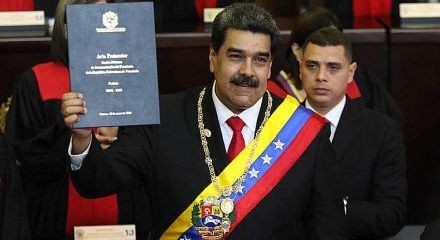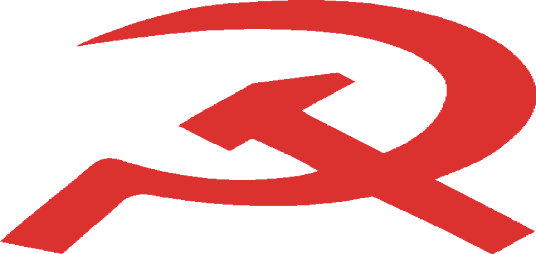06.02.2025

Venezuelan lessons
Chris Gray reviews Chris Gilbert Commune or nothing! Venezuela’s communal movement and its socialist project Monthly Review Press 2023, pp216, £18
Chris Gilbert is a professor of political studies at the Universidad Bolivariana de Venezuela, and co-author, with Cira Pascual Marquina, of Venezuela, the present as struggle (Monthly Review Press, 2020). His book is a good place to start, if you want to find out about the revolution in Venezuela: there is a lot of material in the public domain about it, but this is not reported in the pro-Nato media.
Anthropology - the study of what it means to be human - should be central to any socialist project worth developing, as Marx and Engels and many of their later followers recognised.1 Central to their view was their concept of “modes of production”.2 Capitalism notoriously preserves modes of exploitation and oppression predating its full flowering; however, as Marx and Engels saw, it inevitably calls into being desires and aspirations which the subordinate classes may demand as an alternative.
Gilbert argues that the Bolivarian revolutionaries in Venezuela are trying to develop the urban and rural commune as socialism’s key building block.
Both these aspects together - the incorporation of previous methods of exploitation in mature capitalism and the Venezuelan response - can be seen as an expression of the omnipresent and relentless “law of uneven and combined development”.3
Key component
Hugo Chávez began arguing for the establishment of communes as the revolution’s key component in 2008, and - seizing the opportunity afforded by the torrential floods and rains of 2010, which gave him the power to rule temporarily by decree - began the turn to the commune in the Popular Power Laws passed that year. This turned out to be just in time. Nicolás Maduro, as incoming president after Chávez’s death, faced an imperialist onslaught, which took the form of sanctions and various coup attempts (see p20). The time seemed unpropitious for social experiments, and oil revenues appeared sufficient to carry the country through - but this proved illusory in practice. Fortunately, at this juncture the commune idea began to take root:
It was the time when the rural El Maizal Commune began to seize land in Lara state, when the Andean Che Guevara Commune began to recover cooperative coffee growing and processing its fertile hillsides, and the flagship urban commune, El Panal, set about expanding by building panalito modules throughout the west of Caracas (p21).
For the Venezuelan left, at this point reality started to move towards thought - to the point where in 2023 president Maduro issued a call for that to be “the year of the communes”. As Gilbert points out, this ties in with Marx’s repeated use of the notion of the “associated producers” as a free-growing grassroots movement (p24). This is socialism’s essence, not some form of “state-party vanguardism” (p26).4 This movement’s slogan, endorsed by Chávez, is ¡Comune o nada! (‘The commune or nothing’) (pp27-29).
The first chapter is about the El Maizal Commune - an example of rural self-help, in circumstances where people were starving: a neighbouring pig farm, state-owned, but disused, was taken over, plus a nearby derelict university campus: “The commune’s new assets were immediately set working to produce meat, cheese and farmed fish.” Chris Gilbert records a visit to it and describes its commercial alliance with small, independent producers round about. (Big commerce, a slaughterhouse and a “huge rum-making complex that exports luxury drinks to Europe” still operate close by.) We learn that the commune has an internal parliament (p46), which does not automatically plough back surpluses into the institution, but decides periodically what to do with them - including, possibly, financing other communes. In this last context it has led the launch of a Communard Union to link up existing communes and campaign nationally (p43).
In chapter 3 Chris Gilbert explores the roots of communal production in Latin America, with special reference to Marx’s political development. Alongside Marx in this field we also find two anthropologists, Iraida Vargas and Mario Sanoja. And there is also José Carlos Mariátegui, Peruvian Marxist and author of Seven interpretive essays on Peruvian reality, who focussed on the Incan ayllu (Andean self-governing collective - see p53 and p199, note 5) and advocated communal ownership of land.
This echoes Marx’s approach in his later years, as seen in relation to the Russian, Vera Zasulich, who wrote to him about the Russian peasant commune, the obshchina, and whether it could provide the basis for Russian socialism (see p199, note 8). Vargas and Sanoja were also influenced by Edward Thompson’s The making of the English working class, which he saw as not only the passive product of capitalism, but something actually developed by the workers themselves (p52 and pp57-62). They recognised the valuable part of the Inca legacy.
Unfortunately, Inca traditions also resonate with what I would call the high tribute mode, marked by the presence of an extremely powerful state machine - dedicated, among other things, to the financing of Inca tombs, whose occupants were still seen as needing sustenance in the afterlife. Our anthropologists wisely steer clear of this, and focus on the base of Inca society, and on resistance to the Spanish conquistadores by indigenous Venezuelans and imported blacks. The state, which will continue to exist for a time even in the best scenario, will ultimately need to be transcended by communal organisation.
Chapter 3 is about the Che Guevara Commune, situated in the highlands near Lake Maracaibo. They produce coffee and cacao; coffee in particular is a useful crop for growing in a situation where producers face US sanctions, and it really took off in the wake of the 2008 economic crash (see p74) - with some state financial support. They also introduced a locally based currency, the cafeto - equivalent to a kilo of coffee (p75). This was acceptable while the Venezuelan bolivar had nose-dived and US dollars could not be used - indeed, the local campesinos (peasants/farmers) were already using coffee kilos as units of account (for the disadvantage here, see pp76-77). The cacao factory is run by a collective assembly (p79) and the commune also set up a small school and repaired “an old city bus to take people up and down the steep hillsides” (p80) - all this when abundant oil resources no longer delivered life support.
Our needs first
We then come to the contribution of the Hungarian philosopher, István Mészáros, to the revolution in Venezuela. As Chris Gilbert shows, Mészáros’s thought evolved towards a conception of socialism as the realisation of a communal system of social control. Chris also reveals the limitations of cooperatives per se: “Cooperatives are essentially a kind of collective private property, with their own adversarial relationship with other enterprises, including other cooperatives, with which they compete, and with society at large” (p88).
The chapter on Mészáros shows how both he and Chávez sprang from impoverished, subordinate-class families and how, as a result of their adult experiences, their ideas naturally harmonised. If I have any criticism here, it is only that Chris Gilbert leaves out István Mészáros’s political role in Hungary and his ideological affinity with, for example, the Budapest Central Workers’ Council in the 1956 uprising - an omission which fails to give due recognition to the political initiatives taken by the Hungarian workers in those days.5 As the protégé and philosophical heir of George Lukács (1885-1971), active in the left wing of the Hungarian Communist Party, 1956 undoubtedly had a profound influence on his thought.
The problem is, of course, that the urban environment of the 21st century is not a site of much physical food or refreshment production. For example, in Venezuela, the Luisa Cáceres Commune, located in the port city of Barcelona, tried its hand in processing corn flour, a staple food, but found it could not compete effectively with private producers (see pp105-06). Luckily, the mayor of Barcelona decided to hand over the task of rubbish collection and disposal to nine local communes. Eight of them found this too difficult, but the Luisa Cáceres Commune succeeded by running the whole operation themselves, with their own drivers: the commune now recycles waste products and maintains a plant nursery. Members also occupied a run-down local grocery store providing cheap food (see pp110,113).
Meanwhile, the El Panal Commune (the name means ‘beehive’) swung into action. The group behind it began by suppressing drug dealing in its locality, and then went on to occupy a local bakery, so as to provide residents with bread at a cheap price, diversifying from there in its Distrito Económico (Economic District) into fish farming, pig raising and textile production. Also, like many of the communes, it runs a communal bank, which looks after the financial side of operations. Of particular interest here is tailoring - something widely practised locally, commune or no commune. Members are also beginning to recycle plastic and electrical appliances - an activity which, it is hoped, will give local youth some much-needed employment (pp177-78).
The aim, Gilbert stresses, of communal activity is to put the real needs of the community first, above those of capital production.
-
There is considerable literature on this, starting with Friedrich Engels’ The origin of the family, private property and the state (1884).↩︎
-
My reading suggests the following categories: elementary tribute mode (eg, ancient, pre-Viking Ireland); high tribute mode (the Sumer and the Incas), which decays into feudalism; ancient slavery (classical Greece and Rome); feudalism; capitalism. This is not a hard and fast scheme, and possibly does injustice to slave systems in the Americas: eg, the southern USA, which could well count as a particularly noxious capitalist variant.↩︎
-
See en.wikipedia.org/wiki/Uneven_and_combined_development. See also G Novack Introduction to the logic of Marxism Atlanta GA 1942.↩︎
-
See Marx’s letter to Arnold Ruge, May 1843, in K Marx and F Engels CW Vol 3, which extols “human beings, thinking beings, free men, republicans”.↩︎
-
There is a substantial body of literature on the 1956 Hungarian uprising. See inter alia P Fryer Hungarian tragedy (Durham 1956); B Nagy How the Budapest Central Workers’ Council was set up (Bathgate ND 2006), A Anderson Hungary 56 (Salisbury, undated) and ‘Remembering 1956’ (Revolutionary History Vol 9, no3, 2006).↩︎
